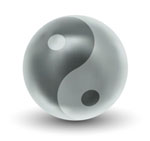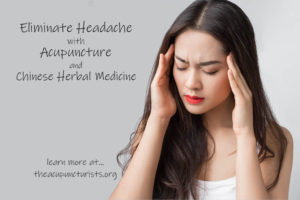By Robert Herbst AP, DOM (AP2502) – Margate, Florida – The pain that headache and migraine sufferers endure can impact every aspect of their lives. Acupuncture can offer powerful relief without the side effects that prescription and over-the-counter drugs can cause. Acupuncture and Chinese Herbal Medicine have been used to relieve headaches and migraines, as well as their underlying causes, for thousands of years and is a widely accepted form of treatment for headaches in our society. We can help you manage your pain with acupuncture and Chinese herbs alone, or as part of a comprehensive treatment program. Let’s take a look at some of the facts regarding headache before we delve into how acupuncture works as treatment for this condition…
Recurring headaches are a manifestation of headache disorders which rank among the top nervous system conditions. Naturally, headaches are painful and can be categorized into two groups:
- Primary headaches – Primary headaches are clinical conditions that are NOT symptoms of other disorders. Primary headaches comprise of migraine, tension headache and cluster headache.
- Secondary headaches – Secondary headaches arise from (and symptomize) other clinical ailments like sinus condition, brain tumor, head injuries, dental problems and allergies among others.
Prevalence and epidemiology of headaches
According to the World Health Organization (WHO) estimates, the prevalence of headache disorders stands at 50% of all adults in the world as cited by Steiner et al (2015). This means that about half the world’s adult population has experienced headache within the last one year. Headaches are most common among the working population whereby up to three quarters of persons aged between eighteen and sixty five years have reported headache disorders in the past one year, and at least 30% of this population suffer from migraines.
Additionally, up to 4% of all adults experience headaches for at least 15 days every month. While there are significant regional differences, headaches are a global problem that affects people in all walks of life irrespective of their geographical zones.
Undoubtedly, headaches are painful and disabling. The 2013 Global Burden of Disease Study established that migraines are the sixth greatest cause of years lost to disability (YLD) globally (Steiner et al, 2015). Collectively, headache disorders were ranked third. The burden imposed by headache disorders on patients is easily recognizable. Some sufferers experience considerable personal miseries, financial strains as well as compromised quality of life.
Recurrent headache attacks as well as perpetual fear of the next attack damages a person’s life at the workplace, home and at a social level. Other conditions usually arise as sufferers grapple with chronic headaches. For instance, compared to healthy people, persons experiencing migraines are in significant greater danger of having depressions.
Differentiating between headaches and migraines
Headaches are nauseating pains in the head which can range from slight to severe aching and can happen at either side of the head. Headaches usually occur at specific points such as the back of the head, temples as well as at the forehead. Headaches can persist from as little as half an hour to as much as an entire week.
- Tension-type headaches are the most prevalent and can be prompted by various issues including anxiety, stress and muscle strain.
- Cluster headaches are another type of headache that comes in clusters and lead to severe pain at one side of the head. Clusters cause a sufferer to experience durations of headache attacks that are followed by instances that are headache-free.
- Sinus headaches accompany other symptoms of sinus infections, for example stuffy nose, coughing and fever.
Migraines can be described as intense headaches that go along with other symptoms apart from head pain. These symptoms include:
- Vomiting
- Temporary loss of vision
- Nausea
- Aching at the rear of one eye (or ear)
- Aching at the temples
- High sensitivity to light (and sound)
- Seeing spots/flashing lights.
While pain from migraines can be moderate, some people experience pain so severe that they seek emergency care. In addition, while migraines usually attack one side of the head, it is not uncommon for people to have migraine headaches at both sides of the head. People with other kinds of headaches such as clusters and tension headaches may carry on with their day to day activities. However, migraine sufferers usually experience throbbing pain that makes it nearly impossible for them to perform daily chores.
Common causes of Headache and Migraine
The majority of headaches are not caused by serious ailments. However, some may occur due to life-threatening illness that require emergency care. Primary headaches usually result from overuse or issues to do with the head’s pain receptive structures. Primary headache doesn’t symptomize an underlying condition. Some people’s primary headaches can be genetic or can result from the brain’s chemical activities. Common primary headaches include migraines, cluster headaches and tension-type headaches. Primary headaches may be elicited by lifestyle factors such as:
- Poor posture
- Stresses
- Skipping meals
- Change in sleep patterns
- Particular foods like processed meat which contain nitrates and
- Alcohol
Secondary headaches symptomize an underlying health condition and can be caused by a wide range of conditions that vary significantly in severity. These causes comprise of acute sinusitis, blood clot in the brain, brain tumor, dehydration, concussion, glaucoma, hangovers, meningitis, stroke, toxoplasmosis, panic disorders and more. Some kinds of secondary headaches are sinus headaches, spinal headaches and rebound headaches.
Typical Western Medical Treatments for headaches
Western treatments for headaches usually involve the recommendation of nonsteroidal anti-inflammatory drugs or NSAIDS. The prescription of painkillers works just fine for occasional headaches. However, regular use of these drugs can cause secondary effects including gastrointestinal conditions like nausea, heartburn and diarrhea, liver stress as well as rebound headaches. Indeed, too much medication is known to cause rebound headaches, whereby excessive medication can be as little as two aspirins per day (Loh et al, 1984).

Acupuncture and Traditional Chinese Medicine in treating headaches and migraines
For thousands of years, TCM has had a remarkably consistent and philosophical outlook regarding the diagnosis, etiology, physiology as well as treatment plan for headaches and migraines. Research results (Linde et al, 2005; Diener et al, 2006; Loh et al, 1984) have consistently shown that acupuncture is a remarkably effective treatment modality for headaches and has been used to provide relief since the beginning of TCM.
Acupuncture needles stimulate nerves to release hormones, such as endorphins, that trigger a response from your body. This immune and circulation system stimulation is how acupuncture relieves migraines and headaches.
Acupuncture offers a huge advantage over Western medications in that it has no known side effects and does no harm. Indeed, numerous patients with chronic and recurrent headaches that had resisted conventional treatments have benefited from the curing abilities of acupuncture as their conditions have healed or shown incredible improvement.
Acupuncture is highly effective in treating headaches, migraines and many other conditions. WHO recognizes acupuncture and TCM as viable treatment alternatives for dozens of conditions. Acupuncture is unique in that unlike Western treatments, it has no side effects and its healing effects are long lasting. A 1984 study established that acupuncture eased chronic shoulder and neck pain as well as related headaches, with symptoms not recurring for months.
If you are suffering with headache or migraine, let The Acupuncturists help. They serve the cities of Margate, Coconut Creek, Coral Springs, Tamarac, Parkland, Deerfield Beach, and West Boca for 15+ years ad are eager to help relieve your pain today. Consultations are always free. Call today!
Web references
- http://www.webmd.com/migraines-headaches/
- http://www.healthline.com/health/migraine/migraine-vs-headache
- http://www.webmd.com/migraines-headaches/guide/migraines-headaches-overview
- http://www.nhs.uk/Conditions/Headache/Pages/Introduction.aspx
- http://www.cochrane.org/CD001218/SYMPT_acupuncture-preventing-migraine-attacks
- http://www.webmd.com/migraines-headaches/news/20120112/acupuncture-may-be-effective-for-migraines#1
- http://www.nyacuhealth.com/migraines-and-headaches
- http://www.webmd.com/migraines-headaches/guide/migraines-headaches-overview
Academic References
- Diener, H. C., Kronfeld, K., Boewing, G., Lungenhausen, M., Maier, C., Molsberger, A., … & GERAC Migraine Study Group. (2006). Efficacy of acupuncture for the prophylaxis of migraine: a multicentre randomised controlled clinical trial. The Lancet Neurology, 5(4), 310-316.
- Linde, K., Streng, A., Jürgens, S., Hoppe, A., Brinkhaus, B., Witt, C., … & Willich, S. N. (2005). Acupuncture for patients with migraine: a randomized controlled trial. Jama, 293(17), 2118-2125.
- Loh, L., Nathan, P. W., Schott, G. D., & Zilkha, K. J. (1984). Acupuncture versus medical treatment for migraine and muscle tension headaches. Journal of Neurology, Neurosurgery& Psychiatry, 47(4), 333-337.ynnand P erl’inman, L. (1984). Acupuncture and migraine.
- Steiner, T. J., Birbeck, G. L., Jensen, R. H., Katsarava, Z., Stovner, L. J., & Martelletti, P. (2015). Headache disorders are third cause of disability worldwide. The journal of headache and pain, 16(1), 1-3.

